MARIANI’S
February
3, 2008
NEWSLETTER
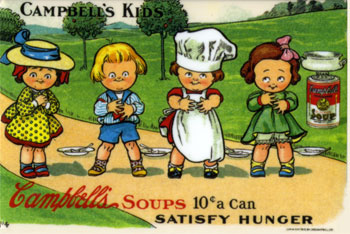
NEW! Click esquire.com
to go to my new column at Esquire Magazine.
ARCHIVE: Readers may now access
an
Archive of all past newsletters--each annotated--dating back to July,
2003, by simply clicking on www.johnmariani.com/archive
SUBSCRIBE AND
UN-SUBSCRIBE: You may subscribe anyone you wish
to this newsletter--free of charge--by
clicking here.
~~~~~~~~~~~~~~~~~~~~~~~~~~~~~~~~~~~~~~~
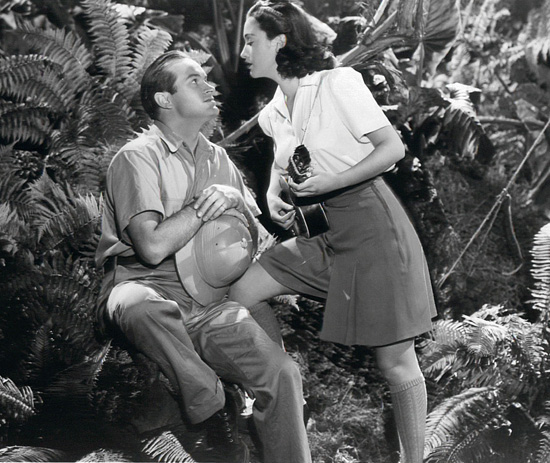
IMPORTANT MESSAGE: There will be no
edition of Mariani's Virtual Gourmet
Newsletter next week, February 10, because Mariani will be on
vacation. Next edition will be February 17.
In
This Issue
NEW YORK CORNER: Pamplona by John Mariani
NOTES FROM THE WINE CELLAR: Riesling on a Roll by Brian Freedman
QUICK BYTES
~~~~~~~~~~~~~~~~~~~
DUTCH TREATS: A Weekend in Amsterdam By Mort Hochstein

I pass a sweeping staircase and go into a small elevator. Each room is different, reminiscent of those in boutique hotels, decorated in modern tones, with attractive functional furniture, good art on the walls, super modern bathrooms, not overdressed, but definitely five stars. Downstairs again, I am shown the building’s former bank vault, now converted into a comfortable wine vault with an adjoining tasting area.
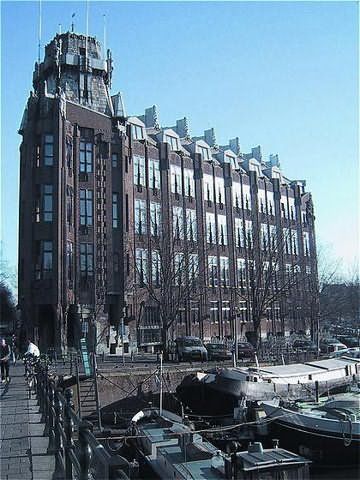
I return at
Familiarly known as the Scheepvaarthuis, that is what I should have told that errant driver and saved us a few euros in cab fare. Reincarnated as the Grand Hotel Amrath (Prins Hendrikkade 108
The hotel's Seven Seas Restaurant (below) is simply laid out, banquettes on one side, tables in the middle, flanking the Art Nouveau windows along the opposite wall, wooden floors, marble fixtures, uncluttered and pleasant. Living up to its name, it is a seafood house, with a few concessions toward carnivores.
What most remains in my memory is a superb Dover sole, perhaps the finest I have ever tasted in a long quest to match my first experience with that incomparable fish many years ago in
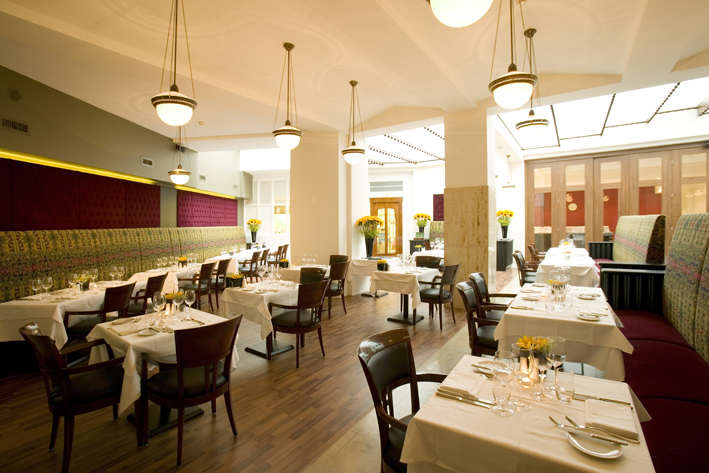 Back to
starters, however. Our table shared
a
plate of grilled scallops dressed in a roasted sweet pepper and olive
oil sabayon, and a mushroom soup that tasted
of
the earth and the woods, loaded with mushrooms and not overburdened
with cream. The bouillabaisse will
forever stand in my pantheon of memorable fish
soups. Our mains included tuna with a piquant lemon-touched butter
sauce, a plâteau de fruits de
mer crammed with lobster, scallops mussels,
crab and rock shrimp as well as cockles, and periwinkles.
Back to
starters, however. Our table shared
a
plate of grilled scallops dressed in a roasted sweet pepper and olive
oil sabayon, and a mushroom soup that tasted
of
the earth and the woods, loaded with mushrooms and not overburdened
with cream. The bouillabaisse will
forever stand in my pantheon of memorable fish
soups. Our mains included tuna with a piquant lemon-touched butter
sauce, a plâteau de fruits de
mer crammed with lobster, scallops mussels,
crab and rock shrimp as well as cockles, and periwinkles.Turbot, another European fish that just does not show well on American tables, was on the menu, so we snapped it up and found it as rewarding as the sole. For dessert, we enjoyed crème brûlée, vanilla flavored, and a selection of fine Dutch cheeses.
The restaurant and hotel have been open since late last summer and there were no flaws in its friendly and professional service. Albeit expensive, the Seven Seas deliver on its promises, and it will be interesting to return in another year to see how it has matured.
Daily menu of 2 courses, 30 Euros; 3 courses 39.50 and 4 courses 45 euros. à
It, too, is a fish house, but somehow Visaandeschelde (Scheldeplein 4; 0031-0-20-675-1583)
Our hotel concierge described Visaandeschelde as
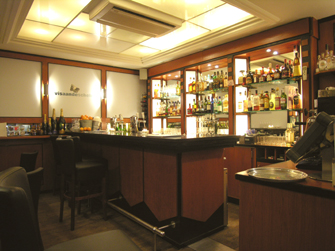
We were, however, in
For starters we chose a plâteau (in Dutch, a platter), a huge elevated plate tumbling over with every kind of seafood and fish imaginable, from lobster to clams to oysters to shrimp, scallops, whelks and periwinkles. I lagged behind my companions, picking out little treasures from the shells of those last two undersized crustaceans long after my tablemates had gone on to their main courses. The platter provided my first experience with the tangy, sea-scented Zeeland oysters, a local treasure seldom seen outside of the
There was a fine bouillabaisse here also, another dish loaded to the gills –no pun intended—with much of the same tasty North Sea seafood, a garlicky rouille only slightly less sharp than its French counterpart, and a soup pungent with all that aroma and body from its briny ingredients. Our dining companions ordered lobster bisque, almost too rich for all that good Dutch cream, morsels of lobster and shrimp swimming in a huge bowl topped by parsley and a swirl of green mustard.
Visaandeschelde offers several sushi plates and a limited meat menu, but ordering beef or poultry would be a total contradiction for going here. One of us
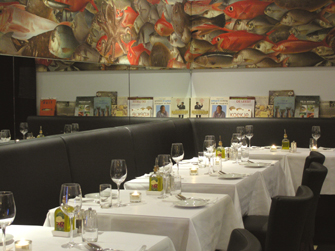 We
also sampled a
grilled sea bream fillet
with braised fennel, accompanied by cannelloni bulging with shrimp and
topped
by sauce americaine, and a
grilled North Sea salmon accompanied by a
Peking
Duck spring roll and haricots vert. Pairings here are creative, and the
sides can
be exciting, as in those fritters, crisp and tasty. It's deserving of a
second
visit if only for that specialty and for that shrimp-enriched cannoli.
We
also sampled a
grilled sea bream fillet
with braised fennel, accompanied by cannelloni bulging with shrimp and
topped
by sauce americaine, and a
grilled North Sea salmon accompanied by a
Peking
Duck spring roll and haricots vert. Pairings here are creative, and the
sides can
be exciting, as in those fritters, crisp and tasty. It's deserving of a
second
visit if only for that specialty and for that shrimp-enriched cannoli.Desserts are limited but enticing: floating island meringue poached in cream with custard sauce, pumpkin pie with fromage blanc ice cream, warm chocolate tartlet with caramelized plums and panna cotta with cinnamon ice cream, liqueur soaked fig and allspice chips. We elected to share the pumpkin pie and the panna cotta and both plates disappeared quickly.
The concierge and the cab driver gave us a good steer; we’ll be back.
Restaurant Visaandeschelde offers chef’s menu for 36.50 euros, 4 courses for 46.50 and 5 courses for 53.50.
Mort Hochstein, former editor and producer for NBC News and the Today Show, and former managing editor of Nation's Restaurant News, writes on wine, food and travel for Wine Spectator, Wine Business Monthly, Saveur and other food and wine publications.
~~~~~~~~~~~~~~~~~~~~~~~~~~~~~~~~~~~~
NEW YORK CORNER
by John Mariani
pamplona
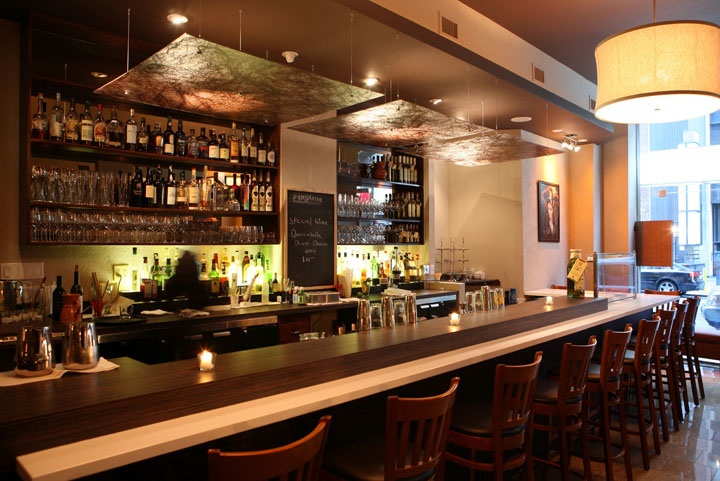
37 East 28th Street (near Park Ave.)
212-213-2328
www.pamplonanyc.com
Alex Ureña has quite a culinary résumé for such a young guy, and he's earned an admirable reputation after stints at Bouley, JoJo, La Côte Basque, La Caravelle, Blue Hill, and Marseilles. So it was inevitable he would open his own place and break out with his own ideas. Along the way he picked up valuable lessons from his Dominican Republic family of good cooks. The result was Ureña, an attempt to explore the wilder shores of contemporary Spanish cuisine à la Ferran Adrià. Unfortunately Ureña didn't last long enough for me to get around to trying it out, but I am happy to report that its transformation into the far more approachable and easy-to-love Pamplona shows the kind of breadth and depth Alex has.
The food of Pamplona focuses on small plates, beginning with some highly inventive tapas and appetizers (below), along with platos principales. Indeed, I found the tapas items more enticing than most of what I'd recently enjoyed in Spain's tapas capital, San Sebastián, where the offerings tend to be very traditional and don't vary that much from place to place. At Pamplona you might begin simply enough with Spanish cheeses or a platter ($18) of four sliced hams and sausages, accompanied by good bread. But there is a lot more you share with friends here, starting with the albondigas meatballs with parsnip puree and a cranberry-tempranillo sauce. His bocadillo of braised rabbit with crema de Cabra goes down in a bite or two, and you'll crave more. Patatas bravas are fried potatoes spiced with paprika and aïoli of garlic-and-oil. and the bacalão croquettes are traditional and very savory, just mild enough in flavor but substantial.
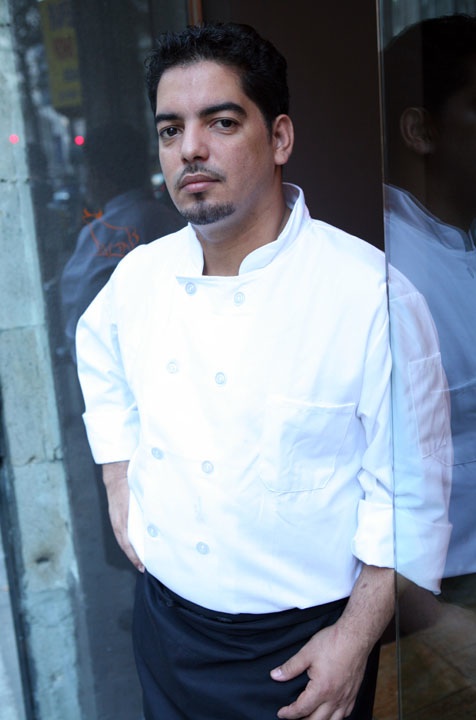 Among the appetizers I recommend the braised
rabbit with caramelized onions and shiitakes, and the poached egg with
truffle oil, a white asparagus salad, chorizo,
and pimiento del piquillo
sauce--all very tantalizing on the tongue and very satisfying.
Poached shrimp comes with rice made creamy by Manchego cheese, with a
chorizo sauce full of zing. Everything here is really alive with
flavors.
Among the appetizers I recommend the braised
rabbit with caramelized onions and shiitakes, and the poached egg with
truffle oil, a white asparagus salad, chorizo,
and pimiento del piquillo
sauce--all very tantalizing on the tongue and very satisfying.
Poached shrimp comes with rice made creamy by Manchego cheese, with a
chorizo sauce full of zing. Everything here is really alive with
flavors.Yes, you could stop after the tapas and entradas, and bringing a slew of friends to Pamplona to do just that is a capital idea. But then you'd miss the main courses like Alex's succulent short ribs with white beans and tempranillo sauce, or one of the three dishes he prepares for two people, like his juicy confit of cochinillo, suckling pig with caramelized apples, tender Swiss chard and the light sweetness of black currants--a really marvelous dish, and at $36 a great deal.
The winelist is a serious one selected to go well with this kind of gutsy, lusty cooking, with nine wines by the glass, sangria by the glass or pitcher, special cocktails, beers, Sherries, Madeiras, and Port. There are about 36 bottlings, split between whites and reds, with an applaudable number of Spanish regional wines under $50, like the delicious Arzuaga La Planta Ribera del Duero 2005 at $45.
Alex Ureña
Desserts are fairly traditional but done with real flair, not least the addictive churros fritters with hot Valrhona chocolate sauce. You might also opt for a plate of cheeses, and there is a tasting of desserts at $15 and $20.
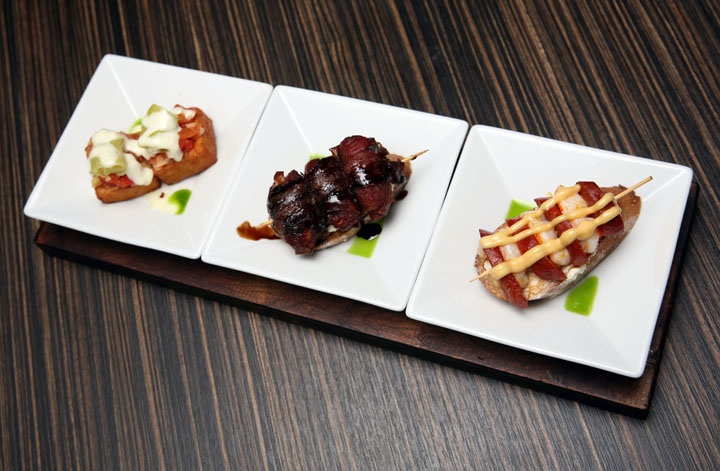
Not that much has been done to the premises, and they are modest indeed, not terribly unlike a coffee shop in this neighborhood, mostly brown, no tablecloths, a few banquettes, and a bar up front. Pamplona could definitely use some color and brightening. The noise level is not too bad though. The service staff, a well-meaning bunch, seems a bit confused in their attempts to describe, even pronounce, some of the dishes and to set a reasonable pacing to the meal.
Food-wise Pamplona hits right in that sweet spot that so many people have these days for exciting, richly flavorful food with individual spark, at prices that allow you to eat a little or a lot or a lot of little things and maybe splurge a bit on a pitcher of sangria. I hope Alex stays in this gear for a long time to come.
Pamplona is open for lunch, Mon.-Fri., brunch, Sat. & Sun., and dinner nightly. Tapas and appetizers range from $5-$15, main courses $18-$38 (for two).
NOTES FROM THE WINE CELLAR
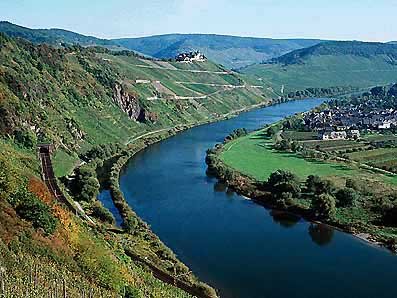 Rieslings on a Roll
Rieslings on a Rollby Brian Freedman
This should come as no surprise to fans of the famous whites of the region: They have, it seems, always been among the most underappreciated—and therefore undervalued—wines in the world. Where else, after all, can you expect to find single-vineyard bottlings that have the potential to age for decades without breaking the bank?
What has made the past two vintages so unique—especially at the Spätlese level—is the potential they offer for both aging and immediate enjoyment at prices that are surprisingly reasonable. In the world of wine, that’s cause for celebration--and for buying as much as you can fit in your cellar.
The sweet spot for riesling is the Mosel-Saar-Ruwer region in the west of
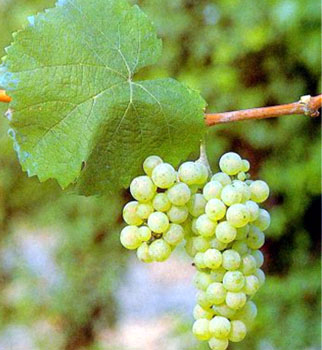 The best vineyard plots tend to face south, which
maximizes
the amount of sun the vines receive each day. They also benefit from
being
planted on steep terraces facing one bend of the river or another,
which
reflects the sunlight back onto the vineyard, warming the grapes and
helping
them develop their all-important sugars.
The best vineyard plots tend to face south, which
maximizes
the amount of sun the vines receive each day. They also benefit from
being
planted on steep terraces facing one bend of the river or another,
which
reflects the sunlight back onto the vineyard, warming the grapes and
helping
them develop their all-important sugars.The 2006 vintage demanded constant attention in the vineyard, as the brutal heat of July, followed by later-season rain, made crop selection a top priority. But the best producers, carefully selecting their fruit and giving them the required TLC in the winery, have another potentially classic vintage on their hands.
The Spätleses, as usual, seem to offer the best drinking at the most appealing prices. They are big steps up in terms of quality from the Kabinetts, yet don’t cost all that much more money. And they are both less expensive and more approachable right now than the riper Ausleses.
I’ve tasted a number of 2006 Spätleses recently, and have, in general, been very impressed. One of the most pleasant right now is Weingut Zilliken’s Saarburger Rausch, a surprisingly light-bodied, deliciously bracing riesling with a nose of Granny Smith apples and flint and a mid-palate that reminded me of crisp autumn fruit, mushrooms, and, unexpectedly, roasted root vegetables.
Selbach-Oster’s Zeltinger Sonnenuhr is a great wine for both riesling neophytes and devotees. It explodes with ripe, exuberant fruit aromas like lychee and white peaches. This is a mouth-coating, tropical-tasting wine that’s kept from being cloying by a much needed hit of lemony acidity and slate-like minerality. It’s a great wine to drink right now—the creamy texture is difficult to resist—or to hold onto for a decade or two and wait for it to really get interesting.
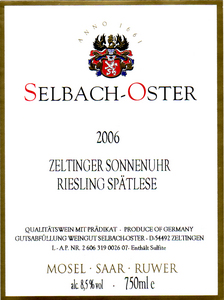
Joh. Jos. Christoffel Erben has always been one of my go-to producers; their rieslings, especially the Spätleses, are not only built for the long-haul, but they’re excellent values, too. They’ve also won me over with their transition to screw-cap closures: I love the peace of mind that comes from not having to worry about cork taint as I wait for a wine to evolve in the cellar.
Christoffel Erben’s Erdener Treppchen has a nose so stony it verges on austere—like a bowlful of wet rocks. But there’s also lovely bright acidity, a hint of orange blossom, and a whiff of citrus fruit. This is a wine for either hard-core riesling fans to enjoy now or collectors with room in their cellar to lay down until it becomes more approachable.
Their Ürziger Würzgarten, on the other hand, is a deeper gold color and more earthy on the nose than the Erdener Treppchen. It also benefits from notes of apple and pineapple, as well as a pronounced smokiness. Still, this is a wine that needs some time to calm down—it is still very much in its youth.
Of course, at these prices (I paid less than $30 for each bottle), you don’t really have to make that impossible choice between opening or laying down a single prized bottle. Because unlike, say, Grand Cru white Burgundy or grande marque vintage Champagne, it’s affordable no matter what your budget is, which means that you can purchase a number of bottles and follow the wine’s evolution over time. In that regard, Spätlese from the
~~~~~~~~~~~~~~~~~~~~~~~~~~~~~~~~~~~~~
SO WHAT WOULD THEY FOR
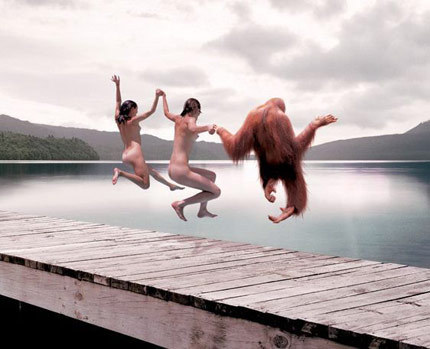
A KLONDIKE BAR?
The Black Frog Restaurant in

AND JUST HOW LONG HAVE YOU BEEN HAVING THESE nightmares, MR. GILL?
"Thick slabs of lard arranged by rather sweaty, nimble fingers to resemble small, dead pudenda. They came with tiny pubic triangles of fried black bread, as impenetrable as roof tiles."--A.A. Gill, Sunday (London) Times.
QUICK BYTES
* On Feb. 4 The Crohn’s & Colitis Foundation, Long Island Chapter hosts “A Toast to Tomorrow” strolling dinner party at Morton’s The Steakhouse Great Neck, with live and silent auctions. $185 pp. Call 516-222-5530.
`
* On Feb. 7 the Chinese lunar New Year will be celebrated at
* Beginning February 20, Maison 140 in Beverly Hills, CA, kicks-off 2008 with the return of its wine & cheese tasting series, Vin et Fromage every Wednesday night at inside the Bar Noir at $25 pp. Call 310-407-7795. Visit www.maison140beverlyhills.com.
* On Feb. 25 in
* On Feb. 27 at Dame Dorothy Cann-Hamilton’s
Everett Potter's Travel Report:

Tennis Resorts Online: A Critical Guide to the World's Best Tennis Resorts and Tennis Camps, published by ROGER COX, who has spent more than two decades writing about tennis travel, including a 17-year stretch for Tennis magazine. He has also written for Arthur Frommer's Budget Travel, New York Magazine, Travel & Leisure, Esquire, Money, USTA Magazine, Men's Journal, and The Robb Report. He has authored two books-The World's Best Tennis Vacations (Stephen Greene Press/Viking Penguin, 1990) and The Best Places to Stay in the Rockies (Houghton Mifflin, 1992 & 1994), and the Melbourne (Australia) chapter to the Wall Street Journal Business Guide to Cities of the Pacific Rim (Fodor's Travel Guides, 1991). THIS WEEK: A Report on The Four Seasons Jackson Hole. Click on the logo below to go to the site.

~~~~~~~~~~~~~~~~~~~~~~~~~~~~~~~~~~~~~~~~~~~~~~~~~~~~~~~~~~~~~~~~~~~~~~~~~
MARIANI'S VIRTUAL GOURMET NEWSLETTER is published weekly. Editor/Publisher: John Mariani.
Contributing Writers: Robert Mariani,
Naomi
Kooker, Suzanne Wright, John A. Curtas, Edward Brivio, Mort
Hochstein, Suzanne Wright. Contributing
Photographers: Galina Stepanoff-Dargery, Bobby Pirillo. Technical
Advisor: Gerry McLoughlin.
Any of John Mariani's books below
may be ordered from amazon.com by clicking on the cover image.
 My
newest book, written with my brother Robert Mariani, is a memoir of our
years growing up in the My
newest book, written with my brother Robert Mariani, is a memoir of our
years growing up in the For those of you who don't think of the Robert and I think you'll enjoy this very personal look at our --John Mariani |
 |
 |
 |
 |
 |
 |
© copyright John Mariani 2008